Overview
Data monitoring for power grids is essential for enhancing the reliability and efficiency of energy distribution systems, as it allows operators to detect anomalies and predict maintenance needs through real-time data analysis. The article highlights that advancements in technologies like IoT and AI are transforming energy management, enabling proactive strategies that not only mitigate outages but also support sustainable resource management and improve overall system resilience.
Introduction
The landscape of power grid management is undergoing a profound transformation, driven by the increasing demand for reliable energy solutions and the integration of advanced technologies. Central to this evolution is the practice of data monitoring, which involves the systematic collection and analysis of data generated by grid infrastructure. This process is essential for optimizing performance, ensuring reliability, and mitigating risks associated with outages.
As regions such as the Middle East and Africa anticipate significant growth in their energy markets, the role of data analytics becomes even more critical. From the deployment of Internet of Things (IoT) devices to the application of artificial intelligence for predictive maintenance, the advancements in data monitoring technologies are reshaping how utilities operate. However, these innovations also bring forth cybersecurity challenges that must be addressed to safeguard critical infrastructure.
This article delves into the multifaceted dimensions of data monitoring in power grids, exploring its applications, challenges, and future trends that promise to enhance the resilience and efficiency of energy systems worldwide.
Understanding Data Monitoring in Power Grids
Monitoring in electrical networks involves the organized gathering, examination, and understanding of information produced by infrastructure, a practice that is crucial for maintaining the reliability and efficiency of energy distribution systems. As the demand for dependable power solutions grows, particularly in the Middle East and Africa, which is projected to increase in market value from 0.33 billion USD in 2023 to 0.35 billion USD by 2032, the significance of robust data monitoring becomes even more pronounced. By consistently monitoring factors such as voltage levels, frequency, and energy flows, operators can quickly detect anomalies, predict maintenance needs, and enhance system performance.
This proactive strategy not only mitigates the risk of outages but also bolsters the overall resilience of energy systems against fluctuations and disturbances. Based on feedback from the Deloitte 2024 energy and utilities sector survey, 'Financing has concentrated on renovating current reactors, but sustainability-themed bonds now also assist new constructions,' emphasizing the increasing acknowledgment of the importance of analytics in improving network operations. As utilities investigate advanced technologies, including small modular reactors (SMRs), which promise to improve network flexibility and safety, the incorporation of thorough information analysis is crucial for attaining sustainability and operational excellence.
Furthermore, case studies on carbon management approaches, like carbon capture and storage (CCS), illustrate how effective information monitoring can result in substantial enhancements in energy system reliability and efficiency, ultimately aiding the shift to more resilient energy networks.
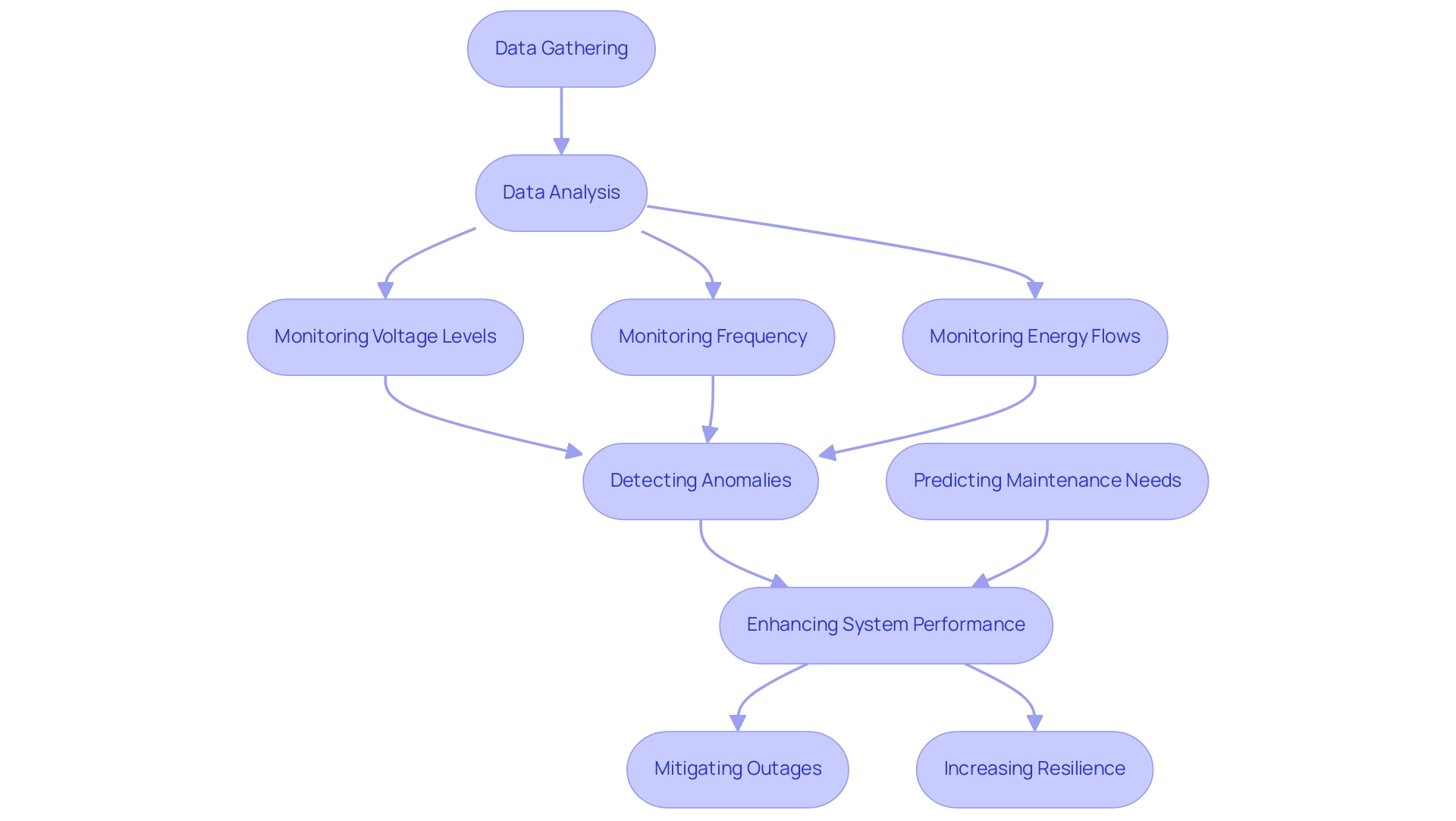
Applications of Data Monitoring Technologies in Power Grid Management
Data monitoring technologies, especially the Internet of Things (IoT) and Artificial Intelligence (AI), are fundamentally altering energy management. By 2030, an estimated 24 billion IoT connections will be in place across various sectors, underscoring the growing reliance on these technologies. In the context of power grids, data monitoring for power grids involves strategically deploying IoT devices to gather real-time information across the infrastructure, which is then analyzed using advanced AI algorithms to identify patterns and predict potential failures.
For example, smart meters not only provide detailed consumption information but also allow utilities to optimize distribution dynamically. As Satyajit Sinha notes, the integration of satellite IoT connections is projected to increase significantly, from six million to 22 million between 2022 and 2027, highlighting the rapid growth in this field. Moreover, AI-driven predictive maintenance can forecast equipment failures before they occur, thereby reducing downtime and minimizing maintenance costs.
The implementation of these technologies not only enhances operational efficiency but also supports effective demand response strategies, paving the way for more sustainable resource management. Notably, the partnership between Advantech and Namla to offer cloud-edge AI orchestration solutions exemplifies the technological advancements in this area. The current investment landscape further reflects this trend, with record levels of venture capital funding in IoT, reaching $1.2 billion in Q1 2022, particularly focused on AI and analytics.
This indicates a robust commitment to building comprehensive technology stacks in energy distribution. Furthermore, the incorporation of generative AI and edge AI is becoming a crucial trend in 2024, with substantial consequences for the future of energy management.
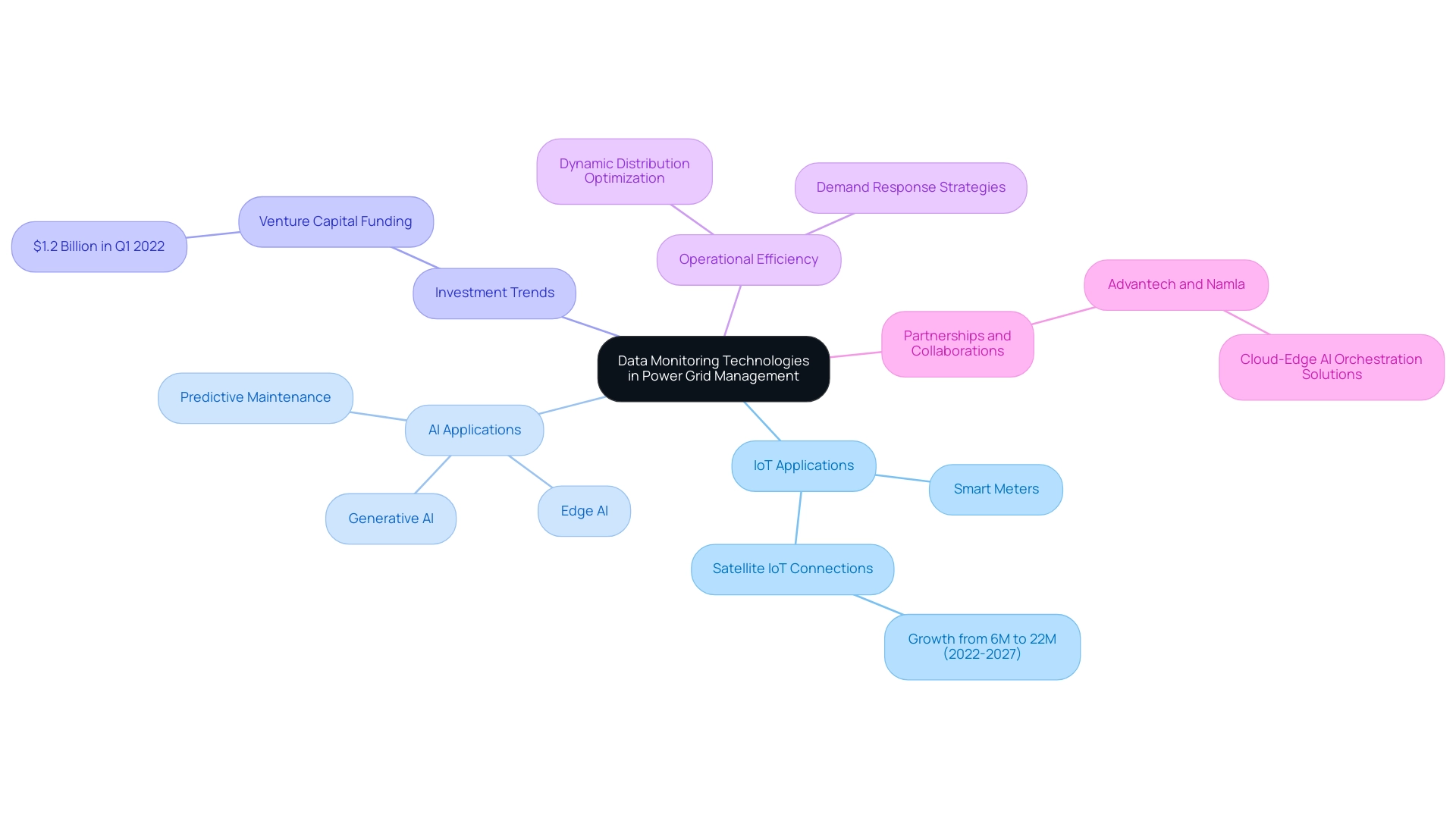
Cybersecurity Challenges in Power Grid Data Monitoring
As energy networks evolve into intelligent systems, they face a growing range of cybersecurity challenges that endanger both information integrity and operational dependability. Recent statistics indicate a troubling trend; for instance, 90% of reported incidents and breaches in 2019 included a phishing component, underscoring the pervasive nature of these threats. Furthermore, the number of known spear-phishing groups grew significantly from 116 in 2016 to over 250 in 2018, highlighting the increasing sophistication of these cyber threats.
Ransomware assaults also present an increasing danger to multiple sectors, including the energy network, highlighting the urgency of addressing these weaknesses. Cyberattacks not only have the potential to disrupt services but can also manipulate critical data and inflict physical damage on infrastructure itself. To effectively mitigate these risks, utilities must implement robust cybersecurity frameworks that encompass:
- Regular risk assessments
- Comprehensive employee training
- Advanced encryption methodologies
Moreover, collaboration with government entities and cybersecurity firms is crucial for developing holistic strategies that safeguard critical infrastructure from emerging threats. By prioritizing cybersecurity initiatives, energy network operators can enhance the resilience of their systems against the dynamic landscape of risks, ensuring continuous and reliable service for all stakeholders. Moreover, as the blockchain market in manufacturing expanded to $85.64 billion in 2022, it serves as a reminder of how emerging technologies can offer both opportunities and challenges in securing energy networks.
By learning from case studies and staying informed on the latest threats, utilities can better prepare for the complexities of modern cybersecurity.
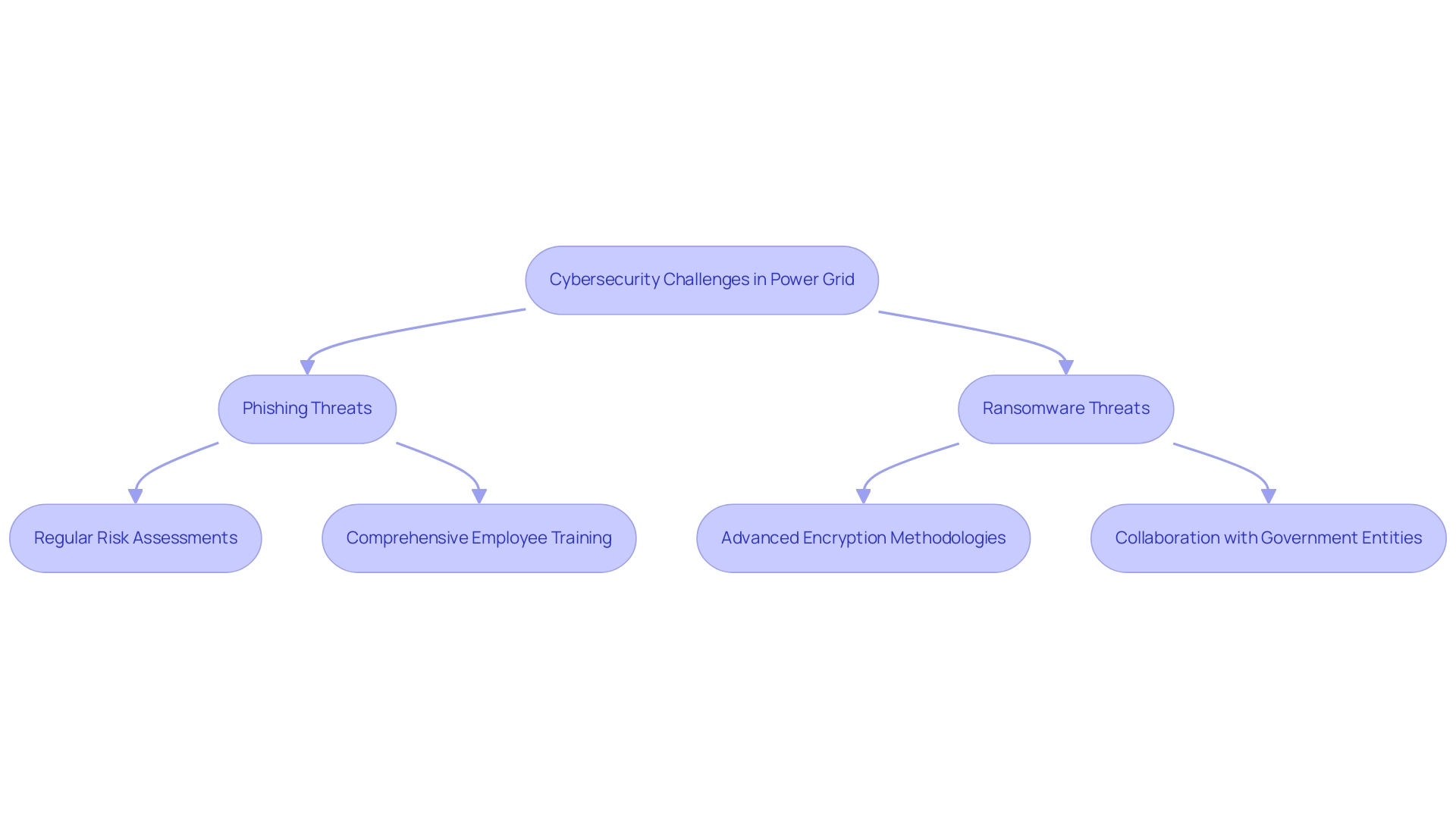
The Role of Data Analytics in Enhancing Grid Performance
Data monitoring for power grids is crucial in enhancing power network performance, enabling operators to make informed choices supported by real-time insights. By incorporating extensive analytics into network management systems, operators can efficiently conduct data monitoring for power grids to examine both past and present information, identify trends, optimize energy distribution, and improve demand forecasting. As emphasized by Siryani et al., the main process of analytics in intelligent networks, particularly in the context of data monitoring for power grids, involves extracting valuable insights from historical information, guiding operational decisions through real-time comparisons.
The research funded by grant # 2022/11182-1 from FAPESP underscores the importance of these insights. Moreover, cooperation among specialists from different domains is crucial for effectively utilizing big data analytics in intelligent networks, especially for data monitoring for power grids, ensuring a comprehensive approach to problem-solving. For instance, advanced analytics enable utilities to pinpoint the most efficient times for power generation and distribution, significantly reducing operational costs while minimizing environmental impacts.
Data monitoring for power grids plays a critical role in identifying sections of the network that necessitate upgrades or maintenance, ensuring optimal resource allocation to bolster overall system reliability. A prominent example is Enel’s E-Distribuzione, which invested €6 million in a remotely controlled and automated primary cabin in Novara Est. This initiative not only boosts operational efficiency but also strengthens control in energy distribution, showcasing how data monitoring for power grids can optimize energy distribution and enhance overall performance on a larger scale.
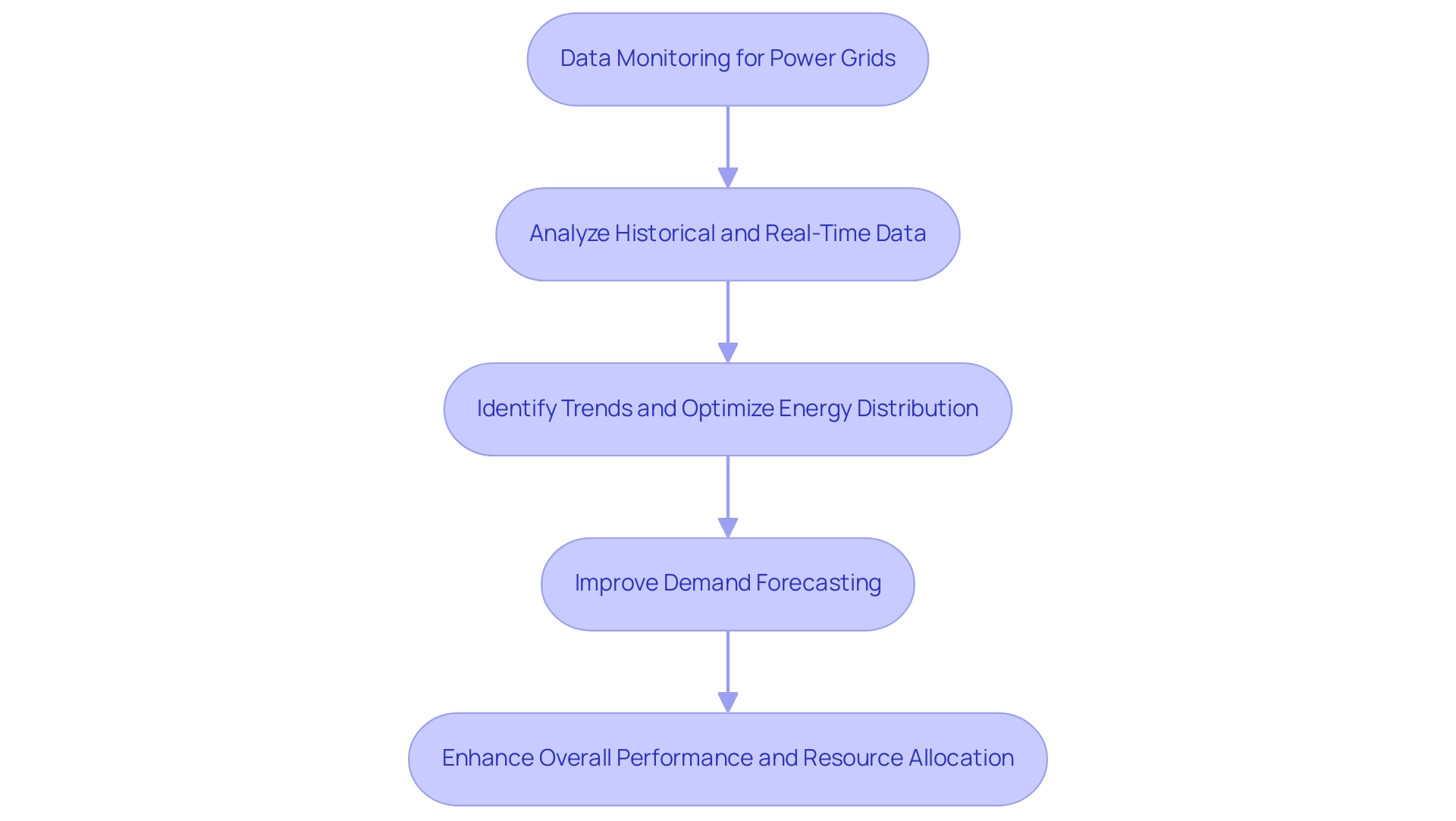
Future Trends in Data Monitoring for Power Grids
The future of data monitoring for power grids is on the brink of transformative advancements, significantly influenced by innovations in smart technology and advanced data analytics. The global AC Smart Grid market is anticipated to grow at a compound annual growth rate (CAGR) of over 10.5% from 2024 to 2030, largely propelled by proactive government initiatives. Central to this evolution is the integration of machine learning algorithms that enhance predictive analytics for network management, enabling utilities to anticipate and respond to demand fluctuations more effectively.
Furthermore, the implementation of distributed power sources requires advanced systems for data monitoring for power grids that can support and optimize these new assets.
In terms of investment, the Power Corporation of India plans to allocate USD 26 billion in the next five years, emphasizing a substantial commitment to improving network reliability through intelligent technologies. This corresponds with recent investments, including the USD 5.1 million designated for the development of a smart microgrid in London's West 5 net-zero sustainability community. As Seamus O'Regan, Minister of Natural Resources, mentioned, this investment is vital for creating and implementing innovative power solutions.
However, it is important to recognize the challenges linked to intelligent network deployment, including significant initial capital requirements and operational expenses, which may limit the expansion of the global intelligent network market. As the power landscape continues to evolve, these trends not only promise to enhance the efficiency and reliability of power grids but also facilitate the transition towards more sustainable systems. Utilities that remain attuned to these advancements will be better positioned to maintain a competitive advantage in the rapidly changing energy market, ultimately contributing to a more resilient and integrated energy future.
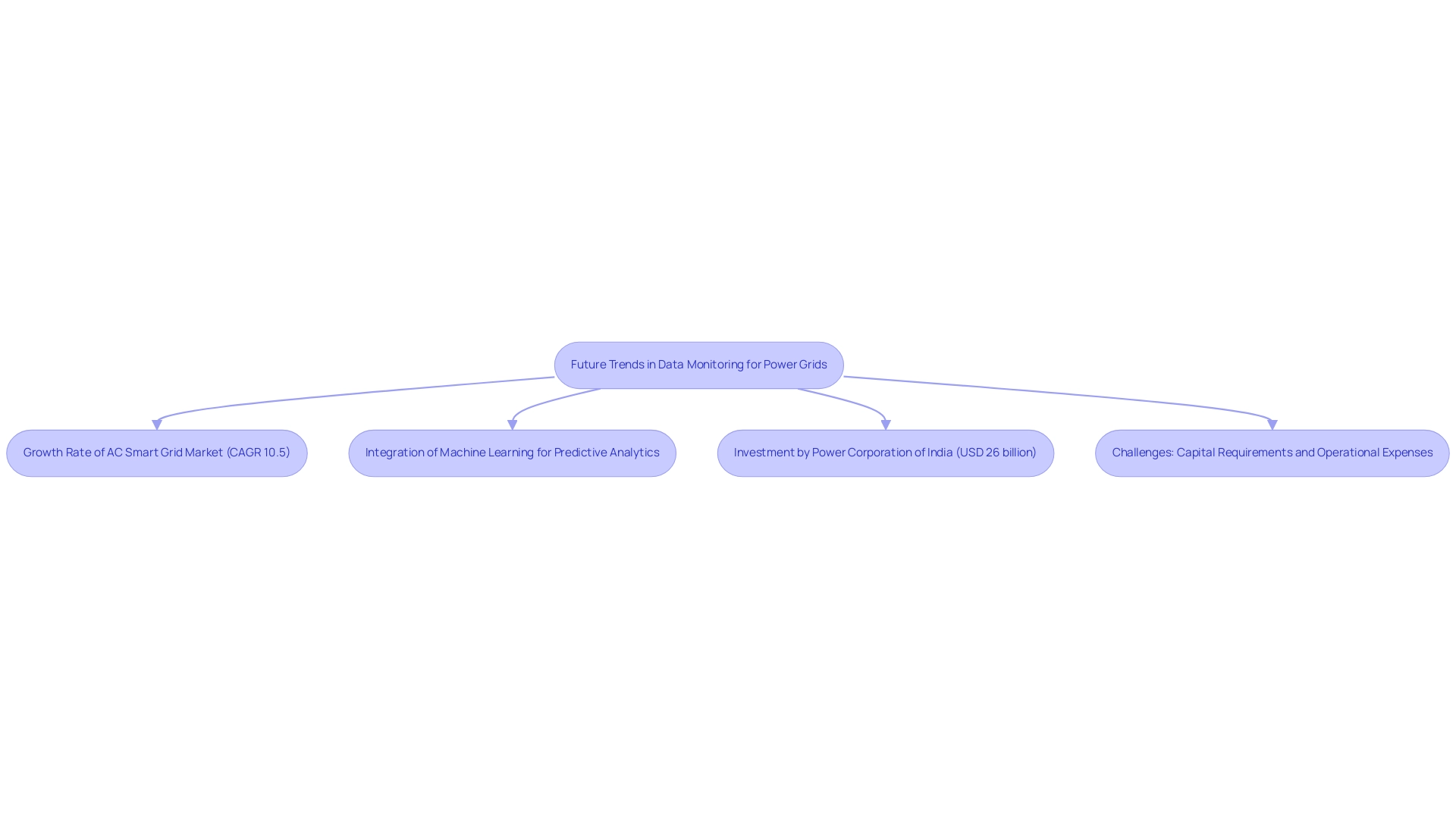
Conclusion
Data monitoring in power grids is crucial for ensuring reliable and efficient energy solutions. By collecting and analyzing data systematically, utilities can optimize operations, anticipate maintenance, and enhance infrastructure resilience, particularly in fast-growing markets like the Middle East and Africa.
The integration of IoT and AI technologies has revolutionized grid management, enabling real-time insights that boost operational efficiency and support sustainable practices. However, the shift to smart grids also introduces cybersecurity challenges that must be addressed to protect critical infrastructure. A robust cybersecurity strategy is essential for maintaining the integrity of these systems.
As the future unfolds, advancements in data monitoring and smart grid technologies will empower utilities to respond more effectively to fluctuating energy demands. Despite the challenges, the potential benefits in efficiency and reliability are significant.
In conclusion, embracing data monitoring technologies is a strategic necessity for utilities. By leveraging these innovations, they can enhance performance, protect infrastructure, and contribute to a more resilient and sustainable energy future.
Frequently Asked Questions
What is the purpose of monitoring in electrical networks?
Monitoring in electrical networks involves the organized gathering, examination, and understanding of information produced by infrastructure, which is crucial for maintaining the reliability and efficiency of energy distribution systems.
Why is data monitoring increasingly important in the Middle East and Africa?
The demand for dependable power solutions is growing in the Middle East and Africa, with the market value projected to increase from 0.33 billion USD in 2023 to 0.35 billion USD by 2032, highlighting the significance of robust data monitoring.
How does consistent monitoring benefit energy distribution systems?
Consistent monitoring of factors such as voltage levels, frequency, and energy flows allows operators to quickly detect anomalies, predict maintenance needs, and enhance system performance, thereby mitigating the risk of outages and improving overall resilience.
What role does analytics play in improving network operations?
Analytics is increasingly acknowledged as important for improving network operations, as evidenced by the Deloitte 2024 energy and utilities sector survey, which highlights that financing is shifting towards sustainability-themed bonds and advanced technologies like small modular reactors (SMRs).
How can effective information monitoring enhance energy system reliability?
Effective information monitoring, as demonstrated in case studies on carbon management approaches like carbon capture and storage (CCS), can lead to significant improvements in energy system reliability and efficiency, supporting the transition to more resilient energy networks.
What technologies are changing energy management?
Data monitoring technologies, particularly the Internet of Things (IoT) and Artificial Intelligence (AI), are fundamentally altering energy management by enabling real-time information gathering and advanced analysis of power grid data.
What is the significance of smart meters in power grids?
Smart meters provide detailed consumption information and allow utilities to optimize distribution dynamically, enhancing operational efficiency.
How is the integration of satellite IoT connections expected to change?
The integration of satellite IoT connections is projected to grow significantly, from six million to 22 million between 2022 and 2027, indicating rapid advancements in this technology.
What advantages does AI-driven predictive maintenance offer?
AI-driven predictive maintenance can forecast equipment failures before they occur, reducing downtime and minimizing maintenance costs.
How are current investments reflecting trends in IoT and AI?
The investment landscape shows record levels of venture capital funding in IoT, reaching $1.2 billion in Q1 2022, particularly focused on AI and analytics, indicating a strong commitment to building comprehensive technology stacks in energy distribution.
What emerging trends are expected to influence energy management in 2024?
The incorporation of generative AI and edge AI is becoming a crucial trend in 2024, which will have significant implications for the future of energy management.

